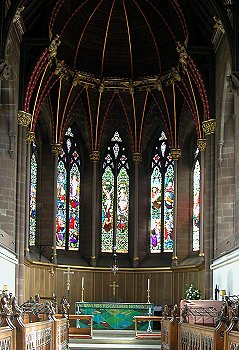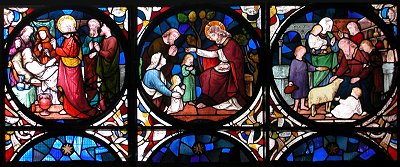|
The Renaissance of Stained Glass
|
“These Gothic windows, how they wear me out,
With cusp and foil, and nothing straight or square,
Crude colours, leaded borders roundabout,
And fitting in Peter here, and Matthew there!”
|
So wrote Thomas Hardy, who had helped “improve” a few
churches with Gothic additions when training as an architect
in the 1860s. The use of stained glass is one example of
Victorian design that has yet to receive the recognition
that it deserves. Until recently, Victorian stained glass
has been vastly underrated, not to say ignored: “insipid”,
“sentimental”, “the glass is Victorian and not worthy of
comment” are typical guide book remarks. Pevsner acerbically
commented that those who wish to study Victorian glass do so
out of “a somewhat morbid aesthetic curiosity”!1
Yet the mid to late 19th century saw what was undoubtedly
the greatest flowering of stained glass manufacture since
the middle ages, and by looking at the windows we often see
the best in 19th century artistic styles. They are “public
art”, if you will. Edward Burne-Jones, for example, saw his
stained glass designs in this light. They were a way of
giving art to those “whose childhoods had been without
beauty” (As his own had been).2
Nor had the windows’ teaching function, so important in
medieval times, been entirely lost for they reminded
church-goers of important tenets of their faith. So while we
can admire Victorian stained glass as art, we can also study
it to learn about how the Victorians saw their God.
In the 19th century techniques for working with and
colouring glass were rediscovered; tougher glass, less
likely to crack or shatter, became available and most
important of all, the demand for stained glass windows for
churches, public buildings and homes was ever increasing.
Whilst it is undoubtedly true to say that much of the
stained glass produced, especially towards the end of the
century, was of inferior quality, a great deal of 19th
century glass is worthy of our attention and further study.
Wolverhampton has excellent examples from several major
workshops; for a provincial town the glass in its churches
is of singular variety and quality. (See section on Artists
and Craftsmen).
|

The fine stained glass windows at the
eastern end of the Chancel in St. Peter's Church, Wolverhampton. |
The reasons
for the 19th century Renaissance in stained glass manufacture
are manifold; some technical, some architectural, others
ecclesiastical. All are in some way connected with a longing for
an ideal past which began with the 18th century Romantic
Movement and which, as we have seen in the chapter on
architecture, later became something of an obsession for certain
Victorian artistic groups such as the Pre-Raphaelites and
architects such as A.W.N. Pugin.
Romantic beliefs about
an “ideal past” were reinforced for those wealthy enough to make
the Grand Tour through France to Italy and often on to Greece.
Such travellers saw not only classical remains but also the
glories of medieval stained glass in cathedrals such as
Chartres. This was a revelation as most English glass, certainly
that of the highest quality, was destroyed at the Dissolution of
the Monasteries and during the Commonwealth. The technique of
stained glass manufacture used in medieval times, especially
that of colouring had been lost. How the medieval glass makers
had achieved the glorious deep blue present in so much of their
work was a mystery. |
|
In the late 1840s a barrister and antiquarian named Charles
Winston, with the assistance of a chemist called Dr.
Medlock, rediscovered the technique for making blue glass.
Other pieces of medieval stained glass were analysed by
chemists at the glass firm of Powell of Whitefriars and
their secrets rediscovered. Chance Brothers of Swethwick
began to produce stronger, clearer glass. This so called
“antique glass” became essential for artists and designers.
As we have seen, architects from the 1840s onwards
increasingly turned towards medieval styles for their
inspiration. It was inevitable that a resurgence of interest
in, and use of the styles of this period should become known
as the Gothic Revival.
Established Church politics also left their mark. The Oxford
Movement of the 1840s founded by J. H. Newman, H.E. Manning
and others aimed at restoring the High Church ideals of the
17th century. Despite the reception of Newman and Manning
into the Roman Catholic Church in 1845 and 1851
respectively, the Oxford Movement’s ideals continued to gain
grounds throughout the 1850s leading to an increasing
interest in Anglican worship and ceremonial, which in turn
had a considerable impact on church design.
|
| All in all,
the stage was set for a demand for “medieval” stained glass. The
new churches, built as existing towns and cities expanded and
new towns grew; and the decaying churches of the established
parishes, lovingly if heavy-handedly restored by Victorian
worthies, all cried out for glass. A number of workshops
fulfilled this demand. |

Part of the north window in the Memorial
Chapel in St. Peter's Church, Wolverhampton. |
| The
greatest was undoubtedly the firm of Morris and Company, much of
whose glass was designed by Edward Burne-Jones. Unfortunately,
Wolverhampton has no ecclesiastical glass from the Victorian
heyday of Morris and Company, although Wightwick Manor has fine
domestic examples and those prepared to travel to Birmingham and
Shropshire will be rewarded by some fine examples. The town does
however contain good examples from other prominent workshops.
Styles in stained glass did not remain constant through the
Victorian period. In the 1850s and 60s “medieval” glass was
popular. It fitted well with the prevailing Gothic style of
the new and restored churches, and many churches installed
windows showing lots of small scenes in predominantly dark
tones which must have made their interiors dim and gloomy.
However, as in else, fashions in glass changed as the
century progressed. By the 1870s and 1880s more naturalistic
designs, with larger scenes and fewer dark colours, were the
order of the day thanks to the influence of the
Pre-Raphaelite and Aesthetic movements. Churches found
themselves without outmoded and unloved windows. So in the
1870s, 80s and 90s many Gothic designs were replaced, having
stayed the course for a remarkably short time. St. Peter's
Church is a good example of this trend. In the 1850s, after
the church was restored, Gothic windows by the top firms of
the day, Hardman and Company and Michael O’Connor, were
installed. By the 1870s these were already being removed and
gradually replaced by the designs that we see today; by the
end of the Great War they were all gone.
Notes:
| 1. |
Pevsner, "The Buildings of England:
Cambridgeshire", p.363. |
| 2. |
Penelope Fitzgerald, Edward Burne Jones,
Hamish Hamilton. 1975, p.85. |
|
 |
|
 |
|
 |
| Return to
Architecture and the Victorians |
|
Return to
the
Contents |
|
Proceed to
Civic and
Public Buildings |
|